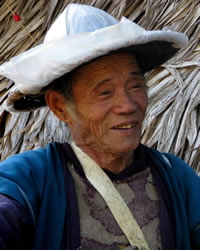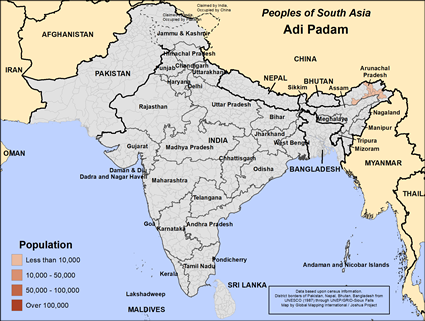Adi Padam in India

Photo Source:
Linda De Volder - Flickr
Creative Commons
|

Map Source:
People Group data: Omid. Map geography: UNESCO / GMI. Map Design: Joshua Project
|
| People Name: | Adi Padam |
| Country: | India |
| 10/40 Window: | Yes |
| Population: | 14,000 |
| World Population: | 14,000 |
| Primary Language: | Adi |
| Primary Religion: | Unknown |
| Christian Adherents: | 30.10 % |
| Evangelicals: | 0.00 % |
| Scripture: | Complete Bible |
| Ministry Resources: | Yes |
| Jesus Film: | Yes |
| Audio Recordings: | Yes |
| People Cluster: | Adi |
| Affinity Bloc: | South Asian Peoples |
| Progress Level: |
|
Introduction / History
Padam is one of the Adi tribes. They live in the East Siang, Upper Siang, West Siang, and Dibang Valley districts of Arunachal Pradesh state in northeastern India.
What Are Their Lives Like?
Adi Padams live in well-planned villages surrounded by jackfruit trees.
They are subsistence farmers who grow rice, beans, corn, millet, and vegetables. They get their meat from pigs, chickens, mithuns (a domesticated bovine), and from hunting and fishing. The latter two are becoming less available due to environmental restrictions. They earn cash by selling handmade bamboo and cane goods. Women make and sell woven goods.
Most marriages are arranged, but they must have the consent of the bride and groom. There is a bride price and they must marry outside their clan. Marriage ceremonies are loaded with rituals and feasting. The entire village comes to participate.
What Are Their Beliefs?
Most Adi Padams are animists, though there is a Christian minority.
What Are Their Needs?
Globalization poses a problem for subsistence farmers anywhere. They are falling further behind the rest of the world, which eventually will challenge their land rights and cause displacement. Those who move to urban centers cannot find adequate work unless they have more education.
Prayer Points
Pray for the Lord to give the Adi Padams the abundant life only Jesus Christ can offer.
Pray for those who follow Christ to follow him more closely.
Pray for them to get the education they need to advance in the coming decades.
Pray for revival fire to move in Adi Padam churches.